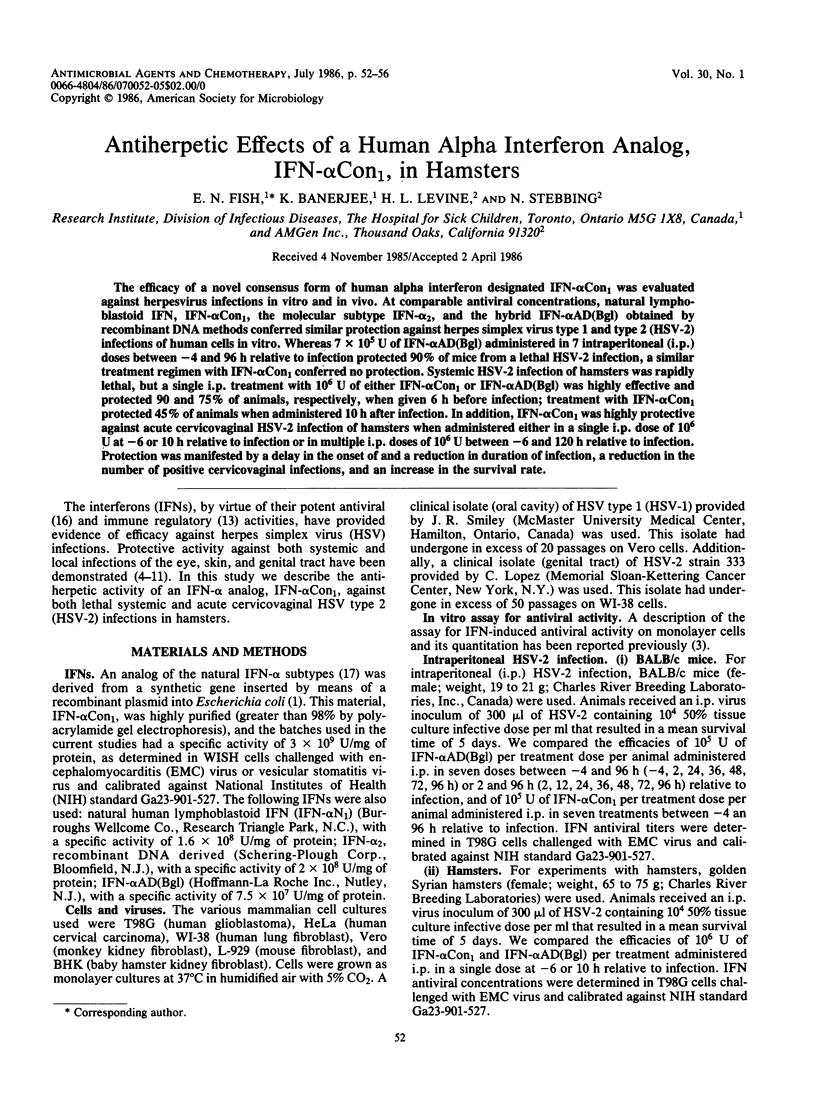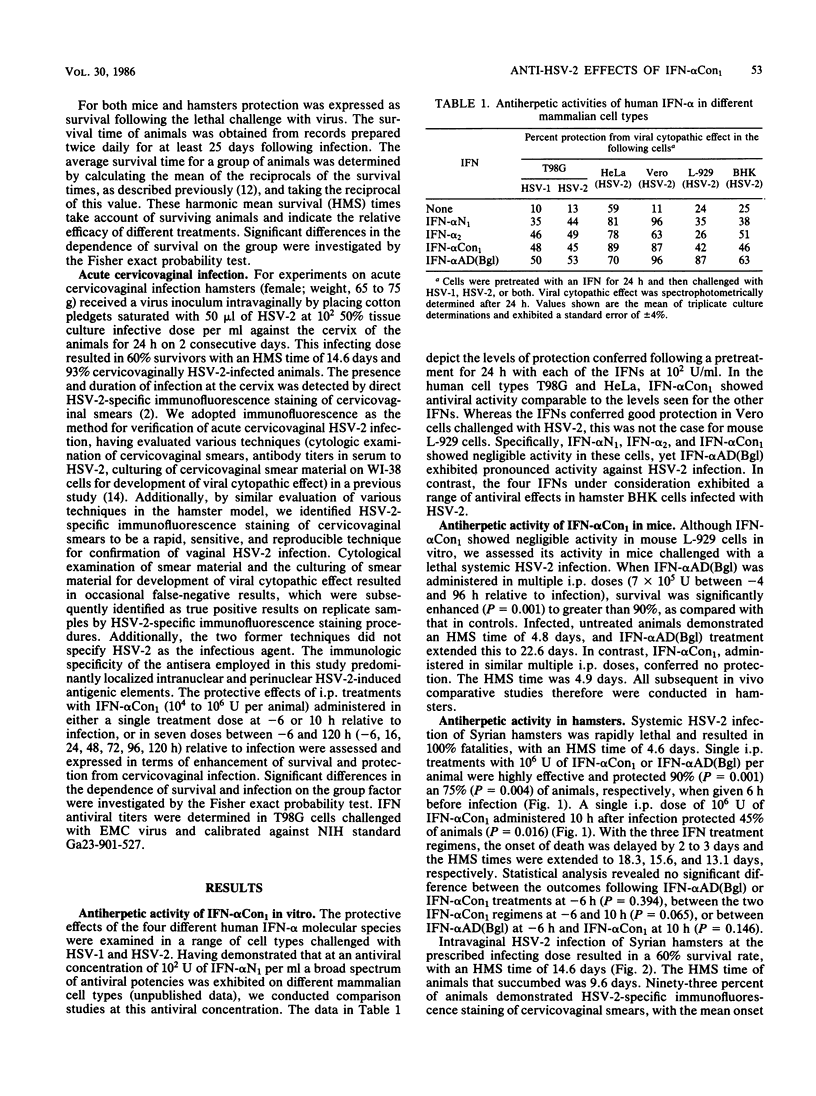Abstract
The efficacy of a novel consensus form of human alpha interferon designated IFN-alpha Con1 was evaluated against herpesvirus infections in vitro and in vivo. At comparable antiviral concentrations, natural lymphoblastoid IFN, IFN-alpha Con1, the molecular subtype IFN-alpha, and the hybrid IFN-alpha AD(Bgl) obtained by recombinant DNA methods conferred similar protection against herpes simplex virus type 1 and type 2 (HSV-2) infections of human cells in vitro. Whereas 7 X 10(5) U of IFN-alpha AD(Bgl) administered in 7 intraperitoneal (i.p.) doses between -4 and 96 h relative to infection protected 90% of mice from a lethal HSV-2 infection, a similar treatment regimen with IFN-alpha Con1 conferred no protection. Systemic HSV-2 infection of hamsters was rapidly lethal, but a single i.p. treatment with 10(6) U of either IFN-alpha Con1 or IFN-alpha AD(Bgl) was highly effective and protected 90 and 75% of animals, respectively, when given 6 h before infection; treatment with IFN-alpha Con1 protected 45% of animals when administered 10 h after infection. In addition, IFN-alpha Con1 was highly protective against acute cervicovaginal HSV-2 infection of hamsters when administered either in a single i.p. dose of 10(6) U at -6 or 10 h relative to infection or in multiple i.p. doses of 10(6) U between -6 and 120 h relative to infection. Protection was manifested by a delay in the onset of and a reduction in duration of infection, a reduction in the number of positive cervicovaginal infections, and an increase in the survival rate.
Full text
PDF




Selected References
These references are in PubMed. This may not be the complete list of references from this article.
- Fish E. N., Banerjee K., Stebbing N. Antiviral activities of cloned human leukocyte interferons against herpes simplex virus type 2 infections of mice. J Gen Virol. 1983 Oct;64(Pt 10):2317–2321. doi: 10.1099/0022-1317-64-10-2317. [DOI] [PubMed] [Google Scholar]
- Fish E. N., Banerjee K., Stebbing N. Human leukocyte interferon subtypes have different antiproliferative and antiviral activities on human cells. Biochem Biophys Res Commun. 1983 Apr 29;112(2):537–546. doi: 10.1016/0006-291x(83)91498-5. [DOI] [PubMed] [Google Scholar]
- Fraser-Smith E. B., Eppstein D. A., Marsh Y. V., Matthews T. R. Enhanced efficacy of the acyclic nucleoside 9-(1,3-dihydroxy-2-propoxymethyl)guanine in combination with beta-interferon against herpes simplex virus type 2 in mice. Antimicrob Agents Chemother. 1984 May;25(5):563–565. doi: 10.1128/aac.25.5.563. [DOI] [PMC free article] [PubMed] [Google Scholar]
- Grabner G., Smolin G., Okumoto M., Stebbing N. Antiviral effects of highly purified bacteria-derived human leukocyte interferons (subtypes A and D) and a human fibroblast interferon against herpes virus infection of the rabbit eye. Curr Eye Res. 1982;2(11):785–790. doi: 10.3109/02713688209020012. [DOI] [PubMed] [Google Scholar]
- Kohl S. Stimulation of human natural killer cytotoxicity and protection of mice from infection due to herpes simplex virus by recombinant human leukocyte interferon. J Infect Dis. 1983 Mar;147(3):484–488. doi: 10.1093/infdis/147.3.484. [DOI] [PubMed] [Google Scholar]
- Levin S. Interferon in acute viral infections. Eur J Pediatr. 1983 Mar;140(1):2–4. doi: 10.1007/BF00661894. [DOI] [PubMed] [Google Scholar]
- Pazin G. J., Armstrong J. A., Lam M. T., Tarr G. C., Jannetta P. J., Ho M. Prevention of reactivated herpes simplex infection by human leukocyte interferon after operation on the trigeminal root. N Engl J Med. 1979 Aug 2;301(5):225–230. doi: 10.1056/NEJM197908023010501. [DOI] [PubMed] [Google Scholar]
- Smolin G., Stebbing N., Friedlaender M., Friedlaender R., Okumoto M. Natural and cloned human leukocyte interferon in herpesvirus infections of rabbit eyes. Arch Ophthalmol. 1982 Mar;100(3):481–483. doi: 10.1001/archopht.1982.01030030483023. [DOI] [PubMed] [Google Scholar]
- Stebbing N., Lindley I. J., Dawson K. M. Variations in the contribution of induced interferon and adjuvanticity to the antiviral effect of different polyinosinic acid . polycytidylic acid formulations in mice infected with encephalomyocarditis virus. Infect Immun. 1980 Sep;29(3):960–965. doi: 10.1128/iai.29.3.960-965.1980. [DOI] [PMC free article] [PubMed] [Google Scholar]
- Tobin S. M., Wilson W. D., Fish E. N., Papsin F. R. Relation of herpesvirus hominis type II to carcinoma of the cervix. An animal model for the induction of long-term latency of herpesvirus hominis type II. Obstet Gynecol. 1978 Jun;51(6):707–712. [PubMed] [Google Scholar]
- Weck P. K., Apperson S., May L., Stebbing N. Comparison of the antiviral activities of various cloned human interferon-alpha subtypes in mammalian cell cultures. J Gen Virol. 1981 Nov;57(Pt 1):233–237. doi: 10.1099/0022-1317-57-1-233. [DOI] [PubMed] [Google Scholar]
- Weck P. K., Rinderknecht E., Estell D. A., Stebbing N. Antiviral activity of bacteria-derived human alpha interferons against encephalomyocarditis virus infection of mice. Infect Immun. 1982 Feb;35(2):660–665. doi: 10.1128/iai.35.2.660-665.1982. [DOI] [PMC free article] [PubMed] [Google Scholar]


